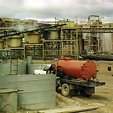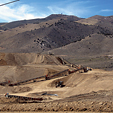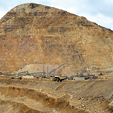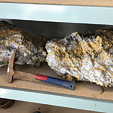Large Scale Mining
Great Panther Silver
January 2011 by Leonard Melman
In late November 2010, a group of analysts and journalists traveled to Guanajuato State, which is a region that is rapidly becoming one of Mexico’s major mining districts. It’s located in a particularly rugged, mountainous portion of Central Mexico, about 260 miles (430 kilometers) northwest of Mexico City. One company actively involved in both production and exploration in Guanajuato is Great Panther Silver Ltd, headquartered in Vancouver, British Columbia. They also own another productive project, the Topia Property, located further north in Durango State.
Great Panther began public trading in 2004, and their first activity was to initiate exploration at the Topia Mines. Those efforts justified the purchase of the mine in 2005, and in the same year they acquired the Guanajuato properties as well. During 2005, work took place to rehabilitate the mines and mills at both locations and by 2006 they were able to initiate production from both projects. Since that time they have worked to increase production as well as to develop additional resources.
Their project in Guanajuato State, where the tour visit took place, is known as the Guanajuato Mine Complex, while the Topia Property is the one found in Durango State. Guanajuato is the larger of the two complexes and figures more prominently in Great Panther’s future plans. Both project areas are particularly rich in mining history, going back several centuries to the time of the Spanish Conquistadores with historic records dating as early as 1538, less than two decades after Cortez conquered the Aztecs and claimed “New Spain” for Spanish king Juan Carlos.
Unlike most mining projects, the Guanajuato Mine Complex—including several ore systems as well as the milling operation—is located directly adjacent to an urban area, in this case the City of Guanajuato with a population of more than 150,000 residents. Fortunately the mining industry formed a significant part of the historic economic base for the city during which more than one billion ounces of silver were produced and residents appear to have accepted the presence of the mine and mill as a matter of course. The company also makes a significant contribution to the area economy by employing about 750 workers at Guanajuato.
In order to continue to advance community relations, Great Panther has worked with city leaders to make a favorable impact on area residents. Community development projects include funding for the Guanajuato School of Mines, a reforestation program to rehabilitate historic mine workings, restoration of old Spanish mining ruins on Great Panther property and the restoration of the historic Valenciana Courtyard for tourism with the admission proceeds going to local charities.

The company acquired the Guanajuato Mine Complex in 2005, and since that time they have carried out extensive drilling programs, both from surface and underground, with particular emphasis being placed on the Cata Clavo Zone. This Zone is located within the more extensive Veta Madre vein system, which contains all Great Panther’s Guanajuato project areas.
By 2009 Great Panther was able to publish a fully compliant, NI 43-101 Resource Estimate based on the Cata Clavo Zone. The estimate used a cut-off net smelter return (NSR) value of $37.50 per tonne and showed a “Measured and Indicated” mineral resource of 5,032,000 silver equivalent ounces comprised of 351,000 tonnes grading 359 grams per metric tonne (gpt) silver (Ag) and 1.19 gpt gold (Au).
The Resource Estimate notes that it is based on a length of only 150 meters and a 100-meter vertical target area that is located within a total strike length of 4.2 kilometers of the Guanajuato deposit.
There are presently five designated contiguous zones named, from west to east; the Guanajuatito, Valenciana, Cata, Rayas and Promontorio. Recent exploration has been focused at two portions of the Rayas Zone known as Los Pozos and Santa Margarita. Los Pozos is a high-grade silver-gold area where the company has been able to report assays of up to 783 gpt Ag and 2.3 gpt Au over a width of 9.6 meters.
Exploration at Santa Margarita is focused on expanding the ore body to depth. Underground drilling activities are initially testing along a 250-meter strike length down to a depth of 650 meters with exploration plans being developed to extend the strike length to 600 meters.
One of the favorable results of Guanajuato’s lengthy productive mining history is the existence of abundant underground tunnels along the entire 4.2 kilometer strike length that have facilitated efficient underground drilling operations. Deep exploration drilling is also being conducted at the Guanajuatito Zone.
In addition, exploration has recently been initiated at an area known as the San Ignacio Mine Property, site of a formerly producing mine where past production took place at just one vein along a 500-meter strike length. The property is located some 20 kilometers away from the Cata Mill, and lies adjacent to Endeavour Silver’s producing Bolanitos Mine. Exploration at San Ignacio is in its early stages, but company geologists already report that the first two holes have intersected several zones of economic grade mineralization. Great Panther plans to drill along a 4-kilometer strike length in order to build new resources for future mill feed.

It is worth noting that the main deep shaft at Cata grew to an unusually large diameter through centuries of mining. Because of this factor, the cages used for transporting personnel have no side supports, but are simply lowered and raised by cables. Some of the tour participants found this unusual, and it is possible that this is one factor which led to the presence of particularly beautiful underground religious shrines that may be found at Guanajuato.
Given the presence of a nearby metropolitan area, infrastructure at the company’s Guanajuato area operations is excellent with good roads, readily available power and water supplies, plus an experienced labor force.
Great Panther’s other producing mine is the Topia high-grade silver-lead-zinc project that covers some 6,500 hectares in Sierra Madre Mountains of Durango State. Mining from 12 veins is presently ongoing and ore is trucked to a plant that currently operates at about 170 tonnes per day. The nearby town of Topia has 3,500 residents and provides for most of the work force, estimated at around 275 employees. Topia is connected to the national power grid, artesian springs provide water to the town, and an installed satellite dish allows for telephone and Internet services.
A recently-completed 8,815-meter drill program was geared to expand silver production at Topia and the company will use data gathered from that program along with previously compiled information from 11 Topia area mines and zones to prepare mineral reserve estimates in the near future.

Combined production from Guanajuato and Topia has increased steadily since 2006 when 638,775 ounces of silver equivalents (AgEO) were produced. Subsequent total annual combined production of AgEO from both properties shows 1,336,629 ounces in 2007; 1,809,720 for 2008; 2,202,456 for 2009 and a preliminary estimate of 2,300,000 for 2010. The company plans to continue expanding their production facilities to enable production to reach 3,800,000 ounces by 2012.
(NOTE: “Silver Equivalent Ounces” are obtained by combining actual ounces of silver production with the total revenue obtained from by-product metal recoveries divided by the current quote on silver ounces.)
The Guanajuato mill flow chart shows facilities for ore to be stored in two bins, sent to a series of crushers, then to flotation cells, then to thickeners where the pregnant solution is skimmed off for drying, ultimately producing a concentrate that is sold before being shipped for final processing. Present plant capacity at Guanajuato is approximately 1,000-1,200 tonnes per day and the figure for Topia is 170-220 tonnes per day.
One notable improvement in the entire exploration/development process at Guanajuato is the construction of a new assay laboratory. While Great Panther paid for construction of the facility, in order to avoid any conflict of interest and for proper validation of reporting, they have turned the operation of the laboratory over to SGS Group, a leading inspection and verification service provider. SGS staffs the laboratory with its own scientists and prepares independent verification of assays. The advantage to Great Panther is a rapid turnaround of assay samples when compared to shipping those samples to out-of-town or even out-of-country laboratories.
_______________
Further information can be obtained by visiting the company’s website at www.greatpanther.com or calling (888) 355-1766.The Snapshot
 Once all the numbers from all the samples and water tests are compiled, a snapshot of the performance of each tank in the process circuit can be seen side-by-side.
Once all the numbers from all the samples and water tests are compiled, a snapshot of the performance of each tank in the process circuit can be seen side-by-side.
Modern Mining Reclamation
 A study showed that between 1930 and 1980, only a quarter of one percent of the land in the United States was used in all mining applications combined, including surface mining, tailings disposal, underground mines, and all mineral processing facilities.
A study showed that between 1930 and 1980, only a quarter of one percent of the land in the United States was used in all mining applications combined, including surface mining, tailings disposal, underground mines, and all mineral processing facilities.
The Basics of Exploration Leases and Contracts—Part II
 This is the point where you might ask, “What do these types of contracts typically look like and how are they negotiated?” Well, that is the topic of this month’s article.
This is the point where you might ask, “What do these types of contracts typically look like and how are they negotiated?” Well, that is the topic of this month’s article.
The Coeur Rochester Mine
 One of the reasons I am bringing this article forward to readers now is that the mine personnel are celebrating the production of 150 million ounces of silver since 1986.
One of the reasons I am bringing this article forward to readers now is that the mine personnel are celebrating the production of 150 million ounces of silver since 1986.
Company Says Central Idaho Project Feasible
...the federal agency is intrigued by a plan that might result in cleaning up the area without cost to taxpayers.
A Father’s Day to Remember: 24,000 Ounces Gold in Quartz
 Father’s Day in Australia was on September 2, and it’s a day a group of miners from “down under” won’t soon forget.
Father’s Day in Australia was on September 2, and it’s a day a group of miners from “down under” won’t soon forget.
Subscription Required:
The Bawl Mill
• Our Readers Say
• Ask The Experts—Amalgamation
• China Gold Imports Increased 500 Percent in 2010
• Tips for Effective Drywashing
• Legislative and Regulatory Update
• The Downieville Gold District
• Rattler's Gold
• Successful Gold Prospecting
• US Mint to Offer Other Precious Metal Coins
• The Business of Mining: Unlimited Possibilities With LLCs
• Silver Boom Prompts Idaho Mine Expansion
• Melman on Gold & Silver
• Mining Stock Quotes & Mineral and Metal Prices









